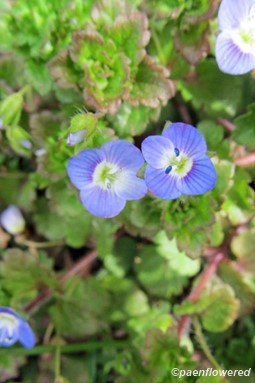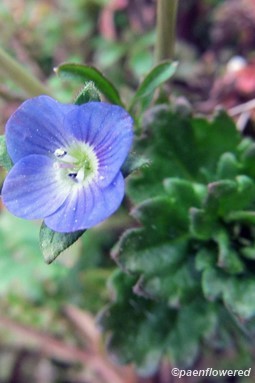Veronica persica
A common, hairy speedwell blooming in early spring
Veronica persica bird's-eye speedwell
This member of the plantain family is native to Eurasia, but has been introduced to North America and other parts of the world. It is known by many common names including bird's-eye speedwell, common field speedwell and large field speedwell.
The plant is an annual or winter annual that reproduces only from seeds. As a winter annual it produces leaves in the autumn and survives over the winter to bloom early in the spring. The plant fades away during the heat of the summer.
The entire plant is hairy. The broad, short-stalked leaves are broadly ovate and have coarsely serrated margins. The leaves are opposite on the lower stem and alternate further up. The stems are weak so the plant grows along the ground, with only stem tips rising upright. The plant thus is a kind of ground cover species. It grows mostly on disturbed ground, including fields and lawns. Many consider it a “weed” since it has no garden or agricultural use. Individual plants can be 4-12 inches long.
The flowers are only 0.4 inches wide, but actually have one of the larger flowers of the speedwell group. The flowers have the 4 petals that are typical of Speedwells with the lower petal smaller than the others. They are sky blue in color with darker stripes and a white center. Sometimes the lower petal will be lighter in color than the other three or even white. The flowers occur individually on long slender stalks that grow from the leaf axils. It blooms from late winter until early summer. The dry fruit is heart-shaped with two widely separated lobes. Each fruit contains 5-10 small seeds.
This species is easily confused with the field speedwell (V. agrestis) that almost always has one white petal. Persian speedwell also looks much like V. chamaedrys, but the latter has flowers on a separate stalk (raceme) instead of arising from the leaf axils. It can also be mistaken for the corn speedwell (Veronica arvensis) but this species has hairy leaves. Common names for the several species of speedwells overlap so much that it is best to use the scientific names when discussing them.
Habitat & Range
Occasional in lawns, roadsides, cultivated fields, and waste ground.
Mostly present in the south of the state.
Wetland code: Not classified
Phenology
Flowers April to October.








.jpg?v=637828013470000000)




Comments
Have you spotted this plant in your area? We'd love to hear about your experience! Share your comments or questions about the plant below. Comments are moderated before posting.